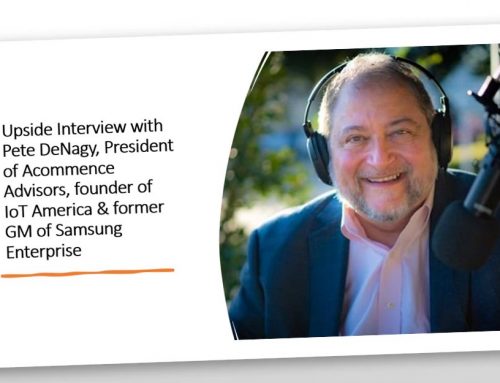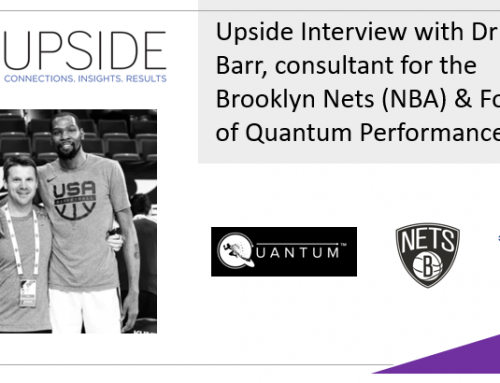This week we had the honor to interview Pete DeNagy, President of Acommence advisors, and founder of IOT America. Pete is also the former GM of Samsung enterprise.
?Show Notes: Throughout our conversation, we touched on his background, his view on the top 5G/WIFI 6 use cases in sports stadiums, the biggest benefits he sees for teams to use 5G/WIFI 6. He also gave his view on how 5G/WIFI 6 can help teams better stay connected to their fans. Lastly we discussed 6G and the killer use cases there.
?Best Quotes: Here’s some of the key discussion points and best quotes from our conversation with Pete:
- On how he started his career in pro sports: “So this happens to be my 38th year in communications mobile and IoT. I have a background in consulting. I worked previously for both Accenture and Capgemini. I’ve also worked in systems integration with EDS carriers. I worked with GTE, Harris and Global Crossing and of course as you had mentioned I was the General Manager of Enterprise for the United States Samsung. I actually helped write Samsung’s global strategy for enterprise mobility”.
- On XR (Mixed Reality, Virtual Reality) as a key 5G, WiFi-6 use case in sports stadiums: “From a use case perspective aside from connectivity, I think the great use case is the XR use case in sports. And what I mean by XR is that we have all heard of virtual reality and augmented reality. I think we’re going to actually see the melding of the two so that fans can go forward, look on the field and actually see augmentation in real time with statistics. So you’ll get the live action experience of being at the stadium, as well as all the graphical capabilities that you get from being at home. So if you watch an NFL game and you see the painted lines per se on the field on your TV set, of course they’re not there in reality, but they are an augmentation of reality that’s presented to you on the TV screen. Well with 5G or with WiFi-6 you’re now going to be able to use your phone or going to be able to use AR glasses or you’re actually going to be able to use XR glasses which have both virtual and augmented capabilities to go forward and get that exact same experience like you would get on your TV set. You’ll be able to see the real time statistics, the percentages, the analytics like you would in the home experience, yet have the robust luster of being at the game which is not something that you can recreate at home or in a restaurant”.
- On the need to have HIPPA compliance to enable live 5G enabled gambling with players’ live biometric data (HR, hydration..) in the future: “So gambling is a huge driver in all this. One of the concerns of course for the biometric statistics, you’re going to have to get player’s consent. Different nations have different rules and in the United States of course there are the HIPPA rules. So the HIPPA rules will actually be applicable on a player by player basis being able to present their individual biometric statistics in a public manner. Some players will opt in and some players will not”.
- On the new use cases that 5G/WiFi 6 will enhance starting with the customer experience (e.g. ordering, concierge services..) in stadiums: “There is the customer intimacy aspect of 5G and WiFi-6. You will have the ability to go forward and provide IoT use cases in the stadium itself for the seating, for ordering, for concierge services, for attendance, for maintenance. Case in point.. You can do this today. You can actually put in sensors in the men’s and the women’s rest facilities per se to see if they need servicing, but one of the things also that you can do is you can track, you can have wearables that are mobile applications for the spectator so you can actually track their motion from within the stadium. What percentage of the time are they sitting? What percentage of the time are they at the bar? What percentage of the time are they in the concourse, where are they spending their dollars? Are they going to go to food concessions, to gift concessions, to clothing concessions? Are they doing activities and games with their children? These things are all available with 5G and WiFi-6. You can architect them directly onto their mobile devices and there are wearables. So I think it’s really important to look at that because at that point the fan experience is much more than just watching the game. The fan experience is actually going out to as they say in baseball, the ball park”.
- On his advice to pro teams and leagues looking to deploy 5G/WiFi 6: “That’s a tremendous question. So the first thing is I would look to architect a system that affords connectivity to whatever service provider is out there. So with 5G of course as we all know carriers bid on spectrum, on specific frequencies to deliver their signal. So they get licenses on regions, areas or nations to go deliver a signal. Therefore it’s really incumbent for the stadium owner to design the distributed antenna system in the stadium to go and support all of the carriers that actually will go forward and utilize that venue. So case in point Verizon could come in, in the United States and deploy a distributed antenna system or a microcell system for 5G and it shuts out T-Mobile and AT&T and that would be bad. So the stadium owner needs to take control of it. Secondarily for a stadium owner there is a trend for private LTE and 5G where actually they own the infrastructure and by owning the infrastructure they can actually deploy what’s called a neutral host and in the neutral host they basically provide the ubiquitous connectivity to all the carriers. And in essence they create a roaming agreement with all the carriers so they can actually share in the revenue stream for each cell call, each data connection. I think that’s really going to be important in that”.
- On the benefits of using WiFI 6: “WiFi-6 has some really nice incumbent benefits. One WiFi-6 affords giggy connectivity and secondly from the AP perspective you actually get a four full distance gain, or more. Right now a WiFi AP using WiFi-5 goes about 150 to 200 meters. A WiFi-6 AP has four times the connectivity, has better channel management, has better battery management and can go up to about 1,000 meters. So that works out really well. It also addresses IoT devices so you can signal out channels for better battery usage. One other thing that the WiFi-6 scenario provides is that WiFi-6 has the ability to do WiFi backhaul, which means that you can mesh the AP’s to in essence you provide the WiFi backhaul from the near end to a far end in a chain of AP’s. This means that you can more efficiently utilize the back bandwidth through that. One of the things that’s of course important in all of this is you need WiFi-6 and, or 5G endpoints and the vast majority of mobile devices carried by consumers today don’t have 5G on them and won’t have 5G on them or WiFi-6 for the very near future. From what I understand we’re going to start seeing commercially deployed WiFi-6 endpoints in the market towards the end of the year. They’re building them in. So you’re not going to see a lot of your consumers yet have 5G and, or WiFi-6 devices in their hands in any type of scale until the beginning of 2022”.
- On the preferred use cases for WiFi-6 Vs uses cases for 5G: “People like Ericsson and Nokia, Samsung, LG in Europe and Asia CTE and HUAWEI are deploying 5G and they’re all talking about private LTE. And owning the infrastructure and the cases therein. What I think you’re going to see is stadium owners forced to do both the WiFi-6 and 5G. So the WiFi-6 will be a deployment that will be less costly than an LTE or a 5G deployment. You’re not looking at a core or a virtualized core or a VRAM and an open RAM type of deployment as microcells. You’re just putting up AP, WiFi APs and you don’t have to put up as many of them. I mean you do have to and look at them from a density perspective and a peak performance perspective. But the downside of WiFi-6 is the fact that when you go forward and you address the connectivity to the AP even though you have four times the capacity that you had before, you still have the problems of running it out. However, the benefits of 5G and the benefits of WiFi-6 are actually pretty closely aligned when it comes to connectivity, with regard to the endpoint. And as a matter of fact there are a lot of initiatives that talk about integrating WiFi-6 and 5G where strategies are that WiFi-6 will end up doing the voiceover IP connectivity to the endpoint and then integrating to the 5G ran core scenario to do the backhaul. It’s very interesting. 5G of course provides some really good security capabilities. Some really good channel capabilities. The channel slicing is interesting in 5G. There are a lot of upsides for doing 5G as well. 5G is going to cost more money than WiFi-6”.
- On the likely emergence of 5G enabled sponsored data with premium content: “I think with 5G you’re going to see a lot of sponsored data with premium content coming into 5G enabled mobile devices whereas you have a data plan and you would have it capped, but with the sponsored data the data price would then be covered by the content issuer. So I think you’ll see a lot of those plans coming out as well. The other thing that you can do is you’ll also be able to, with 5G and WiFi-6 in the stadium itself, from an LBS perspective or a location perspective, push data in real time to the end user. You’re going to see those types of premium services as well and you’re going to do those services in conjunction with the carrier and of course money”.
- On why VR is a killer app in the world of social distancing with COVID-19 today: “VR is absolutely going to be, in a socially distant world, a killer app. One thing I didn’t mention I’m on the board of a VR company MindVR for Alzheimer’s and dementia patients. The problem with VR today is that VR is not a real time experience. You must cache the video, store the video and then replay the video and the audio. Otherwise if you do it in real time, your connectivity must be ubiquitous and at high speed without interruption. Otherwise you get the delay, the fade, the jitter and there are actually physical problems associated with VR”.
- On 6G and the killer use cases: “The good news is that there are a lot of thoughts being going into 6G right now. It’s all academic. Several universities, the University of Oulu also is working on it. They’re in Finland. So if you’re going to ask who’s going to do 6G first, I’m going to tell you it’s going to be either Sweden or Finland and the reason that I say Sweden or Finland is because in Finland Nokia has it headquarters there, and Sweden has Ericsson. So I think they are leading the research. But with the 6G deployments I think you are looking at a lot more contextual awareness. You’re looking at a lot more human machine interface. The target date for 6G is 2030. It’s 10 years away. 1G emerged in 1985, 2G was in 1993, 3G was in 2005, 4G was in 2011 and then so here we are, we’re in 2020 and we’re doing 5G. So it’s pretty much every 10 years”.











Leave A Comment
You must be logged in to post a comment.